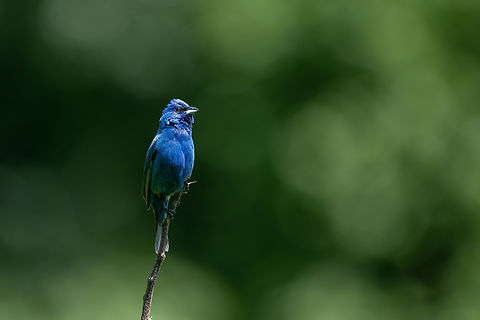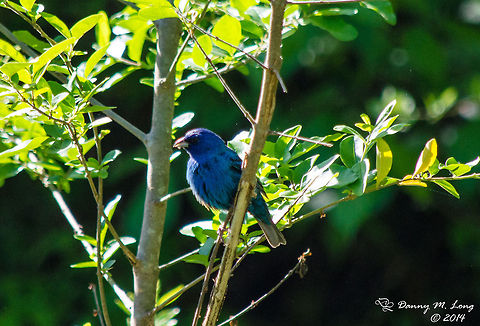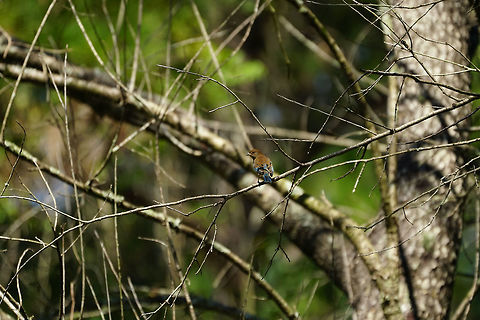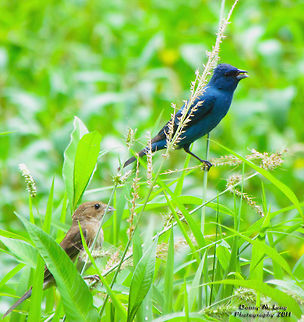
Appearance
The Indigo Bunting is a smallish songbird, around the size of a small sparrow. It measures 11.5–15 cm long, with a wingspan of 18–23 cm. Body mass averages 14.5 g, with a reported range of 11.2–21.4 g. During the breeding season, the adult male appears mostly a vibrant cerulean blue. Only the head is indigo. The wings and tail are black with cerulean blue edges. In fall and winter plumage, the male has brown edges to the blue body and head feathers, which overlap to make the bird appear mostly brown. The adult female is brown on the upperparts and lighter brown on the underparts. It has indistinct wing bars and is faintly streaked with darker markings underneath. The immature bird resembles the female in coloring, although a male may have hints of blue on the tail and shoulders and have darker streaks on the underside. The beak is short and conical. In the adult female, the bill is light brown tinged with blue, and in the adult male the upper half is brownish-black while the lower is light blue. The feet and legs are black or gray.
Distribution
The habitat of the Indigo Bunting is brushy forest edges, open deciduous woods, second growth woodland, and farmland. The breeding range stretches from southern Canada to Maine, south to northern Florida and eastern Texas, and westward to southern Nevada. The winter range begins in southern Florida and central Mexico and stretches south through the West Indies and Central America to northern South America. It has occurred as a vagrant in Antigua and Barbuda, Barbados, Denmark, Ecuador, Germany, Iceland, Ireland, Netherlands, the Netherlands Antilles, Saint Pierre and Miquelon, Serbia and the United Kingdom.
Status
The species is of Least Concern according to the IUCN, with an estimated range of 5,900,000 km2 and a population of 28,000,000 individuals. Global population trends have not been quantified, but the species is not believed to approach the thresholds for a population decline warranting an upgrade in conservation status. The criteria for a change in conservation status are a decline of more than 30% in ten years or over three generations.
Behavior
The Indigo Bunting communicates through vocalizations and visual cues. A sharp "chip!" call is used by both sexes, and is used as an alarm call if a nest or chick is threatened. A high-pitched, buzzed "zeeep" is used as a contact call when the Indigo Bunting is in flight. The song of the male bird is a high-pitched buzzed "sweet-sweet chew-chew sweet-sweet", lasting two to four seconds, sung to mark his territory to other males and to attract females. Each male has a single complex song, which he sings while perched on elevated objects, such as posts, wires, and bush-tops. In areas where the ranges of the Lazuli Bunting and the Indigo Bunting overlap, the males defend territories from each another. Migration takes place in April and May and then again in September and October. The Indigo Bunting often migrates during the night, using the stars to direct itself. In captivity, since it cannot migrate, it experiences disorientation in April and May and in September and October if it cannot see the stars from its enclosure.Habitat
The habitat of the Indigo Bunting is brushy forest edges, open deciduous woods, second growth woodland, and farmland. The breeding range stretches from southern Canada to Maine, south to northern Florida and eastern Texas, and westward to southern Nevada. The winter range begins in southern Florida and central Mexico and stretches south through the West Indies and Central America to northern South America. It has occurred as a vagrant in Antigua and Barbuda, Barbados, Denmark, Ecuador, Germany, Iceland, Ireland, Netherlands, the Netherlands Antilles, Saint Pierre and Miquelon, Serbia and the United Kingdom.Reproduction
These birds are generally monogamous but not always faithful to their partner. In the western part of their range, they often hybridize with the Lazuli Bunting. Nesting sites are located in dense shrub or a low tree, generally 0.3–1 m above the ground, but rarely up to 9 m. The nest itself is constructed of leaves, coarse grasses, stems, and strips of bark, lined with soft grass or deer hair and is bound with spider web. It is constructed by the female, who cares for the eggs alone. The clutch consists of one to four eggs, but usually contains three to four. The eggs are white and usually unmarked, though some may be marked with brownish spots, averaging 18.7 mm × 13.7 mm in size. The eggs are incubated for 12 to 13 days and the chicks are altricial at hatching. Chicks fledge 10 to 12 days after hatching. Most pairs raise two broods per year, and the male may feed newly fledged young while the females incubate the next clutch of eggs.The Brown-headed Cowbird may parasitize this species. Indigo Buntings abandon their nest if a cowbird egg appears before they lay any of their own eggs, but accept the egg after that point. Pairs with parasitized nests have less reproductive success. The bunting chicks hatch, but have lower survival rates as they must compete with the cowbird chick for food.
Food
The Indigo Bunting forages for food on the ground or in trees or shrubs. In winter, it often feeds in flocks with other Indigo Buntings, but is a solitary feeder during the breeding season. During the breeding season, the species eats insects, seeds and berries, including caterpillars, grasshoppers, spiders, beetles, and grass seeds. The seeds of grasses are the mainstay of its diet during the winter, although buds, and insects are eaten when available. The young are fed mainly insects at first, to provide them with protein. The Indigo Bunting does not drink frequently, generally obtaining sufficient water from its diet.References:
Some text fragments are auto parsed from Wikipedia.